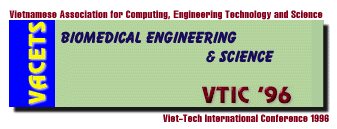
AUTOMATICALLY MEDICATED INSTRUMENT FOR EYEDROPS
Vo Van Toi*, Ph.D., P.A. Grounauer**, M.D, and C. Weder*
* Tufts University
Electrical Engineering and Computer Science Department
Biomedical Engineering Laboratory
Medford, MA 02155 USA
E-Mail: [email protected]
** Hopital Ophtalmique Universitaire de Lausanne, Switzerland.
Abstract
We herein describe an eyedrop delivery device which can be mounted on
any eyeglass frame and ejects eyedrop into a patient's eyes without
requiring major interaction from the patient. Monitored by a microcomputer
this device administers microdroplets of medication automatically at a
programmable rate or on demand. It is useful for patients with dry eyes
or for those who need constant or long term treatment.
CHALLENGES IN MACROMOLECULES STRUCTURAL DETERMINATION
Nguyen-huu Xuong
Department of Physics, Biology, Chemistry and Biochemistry
University of California, San Diego
La Jolla, CA 92093-0359 USA
Phone (619) 534-2501, Fax (619) 534-6174
E-Mail: [email protected]
Abstract
Macromolecular crystallography, i.e. the determination of the study
of three-dimensional structure of proteins and DNA and RNA molecules, is
situated at the interface of Physics, Biology and Medicine. One of my
early contributions to this field was the adaptation of the "Multiwire
Proportional Chamber" from high energy physics to a "Multiwire X-ray
Area Detector." A high speed data collection system using these detectors
revolutionized the way one collects data for protein crystallography
making it faster, simpler and reducing the required number of protein
crystals by an order of magnitude. These systems are still in use in
many laboratories and biotech companies all over the world. Using a similar
system my group has collaborated with other scientists to solve structures
for proteins involved in cancer, AIDS and in signal transduction process
(protein kinases). Recently my group has been awarded a generous grant
from the National Institutes of Health to develop a "Smart Pixel Array
Detector" for protein crystallography that will be a thousand times faster
than the old Multiwire detector. When finished, this detector will allow
us to detect conformational changes of a protein in a period as short as
ten milliseconds and therefore understand its biological function much
better.
EXTENDED RENAL PRESERVATION WITH UW SOLUTION
Dai D. Nghiem, Shyuan Hsia, James Schlosser and Joseph Lucke
Department of Surgery and Laboratory Medicine
Allegheny General Hospital and Allegheny-Singer Research Institute
Pittsburgh, Pennsylvania, USA
Abstract
ENDOSCOPIC MANAGEMENT OF BILIARY AND PANCREATIC DISEASES IN THE 1990'S
Loc T. Le, M.D.
Abstract
Advanced medical technologies in the 1990's have changed the way medical
care is delivered in the United States and other industrialized countries.
Today, physicians are able to effectively perform many complex and
sophisticated procedures on their patients in an easy, safe, less invasive,
and accurate fashion. Among the most important advances in these innovative
medical technologies is the flexible fiberoptic and videoendoscopic
technology. It revolutionalizes the conventional approaches to cardiovascular,
genitourinary, oncological, and gastrointestinal diseases. This paper
provides an overview of the application of endoscopic technology to the
pancreatico-biliary system (the bile duct, gallblader, liver, and pancreas)
as it is applied in the 1990's. It broadly explains the endoscopic
technology and briefly discusses the applications to specific diseases
of the liver and pancreas.
MICRODOSIMETRY STUDY OF 10B (n,a)7 Li REACTION IN CELLS USING MONTE CARLO'S SIMULATION
Tien Nguyen
Nguyen Technology and Consultant
Vancouver, WA 98683
Abstract
A Monte Carlo simulation has been employed to calculate and compare
the absorbed dose and effective dose in the modeled cells when 10B is
localized in 5 regions: cell nucleus, nuclear membrance, cytoplasm, cell
membrance, and extracellular. The simulation considers 2 independent
target regions: nucleus and whole cell. Three factors have been found
to affect the doses in the target regions of modeled cells of the same
size: number of 10B disintegrations in the source region, the distribution
of hit sizes in the target region, and the model geometry. An effectiveness
factor (EF) concept has been defined, combining the 3 mentioned factors,
to be used as a scale to weigh the effect of 10B localized in the 5 source
regions. Results of a simulation using the subcellular distribution of
5 different boron compounds, BSH, BSSB, BOPP, and VCDP, is also presented.
NEW CONCEPTS IN THORACIC ORGAN TRANSPLANTATION
Si M. Pham, M.D.
Assistant Professor of Surgery
Director of Adult Heart Transplant Service
University of Pittsburgh School of Medicine
Suite C-700 PUH
200 Lothrop Street
Pittsburgh, PA 15213 USA
Abstract
The history of transplantation has been compressed, for the most part,
into the past century. Tremendous progress has occurred, and the concept
of replacing a defective organ or cell with a functioning graft has become
a clinical reality. The success of this field is mainly due to the development
of nonspecific immunosuppressive agents to prevent rejection. However,
these agents are associated with significant morbidity and mortality.
Furthermore, these agents are far from perfect in preventing rejection. As
a result, rejection is still a major cause of graft loss and death.
Donor-specific transplantation tolerance, a state in which the host
permanently accept the transplanted graft without immunosuppression so that
the host is still immunocompetence to respond to normal challenges, seems
to be an obvious solution to the current limitations in clinical elusive
goal. To date, donor cell chimerism appears to associate strongly with
long term graft acceptance, and in some cases, without the need for
continuation of immunosuppression. With recent advances and renewed
interests in this field, achieving donor-specific transplantation tolerance,
which has remained elusive during the last five decades, is approaching
in the horizon.
VORTEX NEBULIZER: A MEDICAL APPLICATION OF CONFINED VORTEX FLOW PHENOMENA
Ngo Dinh Thinh, Ph.D.
Professor and Chair
Department of Mechanical Engineering
California State University, Sacramento
Sacramento, CA 95819-6031 USA
E-Mail: [email protected]
Abstract
This paper describes the design an development of a vortex nebulizer
for use with new and innovative medical applications. The unique and
beneficial features of the vortex phenomena in conjunction with the
liquid atomizing process are demonstrated.

